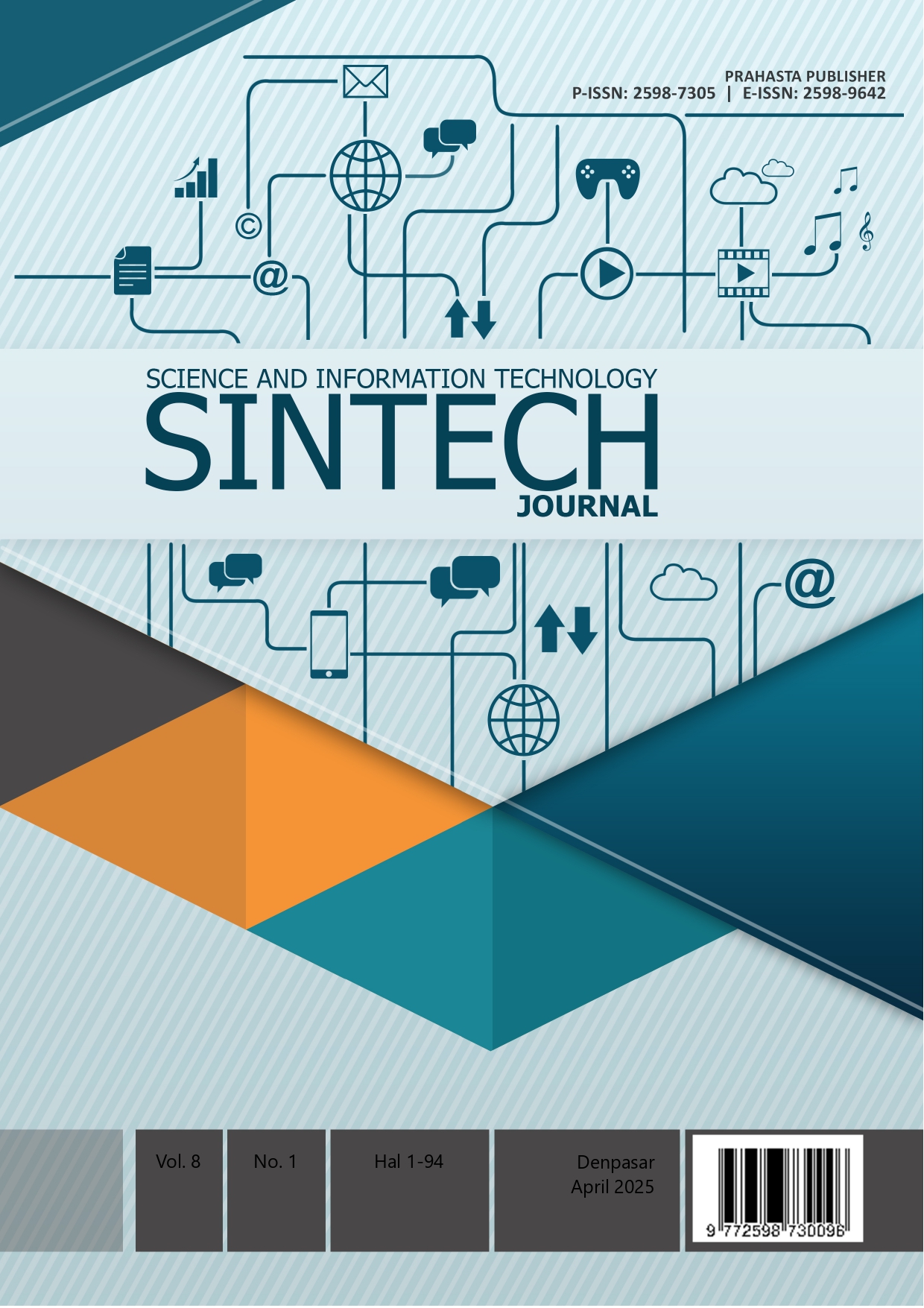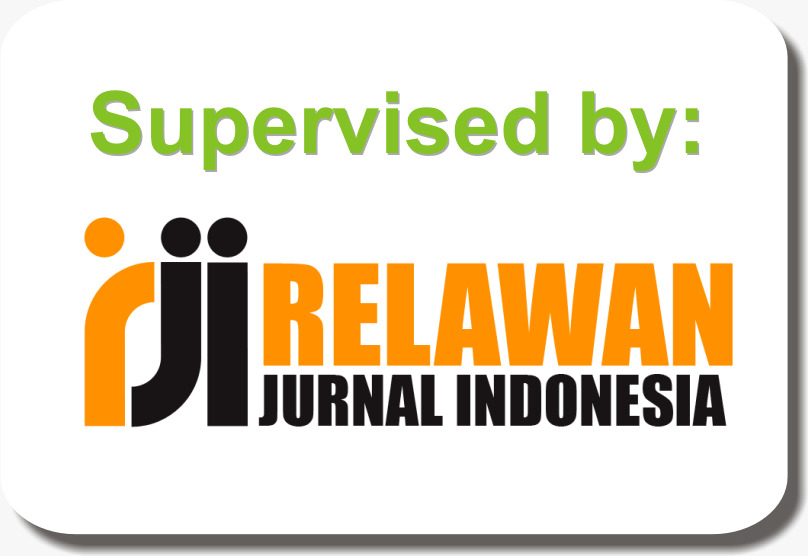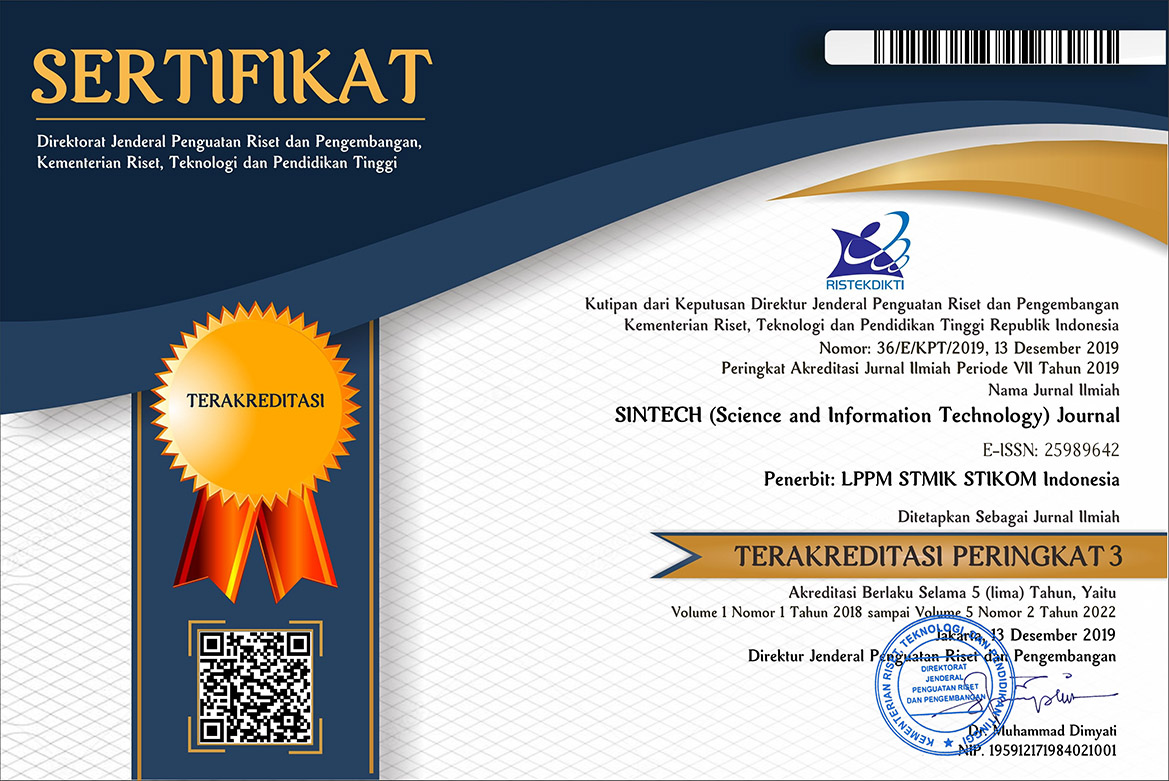Understanding Public Sentiment on Jakarta Public Transportation Using LSTM
DOI:
https://doi.org/10.31598/sintechjournal.v8i1.1800Keywords:
sentiment analysis, mass public transportation, traffic congestion, NLP, LSTMAbstract
Traffic congestion is a major issue in Jakarta due to the number of vehicles exceeding road capacity. To address this, the Jakarta government has introduced various types of public transportation to drive commuters to shift to mass public transport from using private vehicles. However, the question remains: is the public transportation system optimal? Understanding public sentiment is crucial for optimizing the available transport options. This research aims to understand the public sentiment from social media using the LSTM method. By examining how people perceive the current state of mass public transportation, we can evaluate its effectiveness. From the approximately 1000 data from social media and google review that were processed in this research, the results show that using BiLSTM could reach an accuracy of 94% for datasets that only have Positive and Negative Sentiment and 74% for a dataset that consists of Neutral sentiment too. Ultimately, this study hopes to provide and deliver a summary of the public transportation system utilized by the NLP and LSTM algorithm, and also serve as an evaluation tool to improve services for encouraging a shift from private vehicles to public transport which can reduce traffic congestion in Jakarta.
References
“Jakarta traffic report | TomTom Traffic Index.” Accessed: Jul. 12, 2024. [Online]. Available: https://www.tomtom.com/traffic-index/jakarta-traffic/
BPS Provinsi DKI Jakarta, “Transportation Statistics of DKI Jakarta 2022,” 2023.
Devi Puspitasari, “Kemenhub Ungkap Kerugian Akibat Kemacetan Jakarta Capai Rp 65 Triliun,” DetikNews. Accessed: Jul. 12, 2024. [Online]. Available: https://news.detik.com/berita/d-6795414/kemenhub-ungkap-kerugian-akibat-kemacetan-jakarta-capai-rp-65-triliun
M. Kamruzzaman and Z. F. Rumpa, “The Effect of Traffic Congestion on Employee Productivity in Dhaka Bangladesh,” The International Journal of Business & Management, vol. 7, no. 5, May 2019, doi: 10.24940/THEIJBM/2019/V7/I5/BM1811-023.
T. D. Weerasinghe, I. Karunarathna, and C. Subhashini, “Effect of Road Traffic Congestion on Stress at Work: Evidence from the Employees Working in Metropolitan Areas of Colombo, Sri Lanka,” 2021, Accessed: Jul. 12, 2024. [Online]. Available: https://www.researchgate.net/publication/351281226_Effect_of_Road_Traffic_Congestion_on_Stress_at_Work_Evidence_from_the_Employees_Working_in_Metropolitan_Areas_of_Colombo_Sri_Lanka
Ii. S. D.R, A. Buqhari, and O. Andy, “THE EFFECT OF STRESS AND PRODUCTIVITY DUE TO TRAFFIC CONGESTION AMONG WORK,” Proceeding of International Conference Health, Science And Technology (ICOHETECH), 2023, Accessed: Jul. 12, 2024. [Online]. Available: https://journals.indexcopernicus.com/search/article?articleId=3757262
BPS Provinsi DKI Jakarta, “Transportation Statistics of DKI Jakarta 2024.” Accessed: Jul. 12, 2024. [Online]. Available: https://jakarta.bps.go.id/publication/2023/11/23/50c5745cdc2f0949e4fc47ec/statistik-transportasi-provinsi-dki-jakarta-2022.html
A. Pristanto, O. T. Lauren, D. Aryani, and S. Sahara, “Analisis Kepuasan Pelanggan Terhadap Fasilitas yang Disediakan oleh Pihak Transjakarta,” Jurnal Manajemen Riset Inovasi, vol. 1, no. 3, pp. 09–17, May 2023, doi: 10.55606/MRI.V1I3.1162.
M. I. Cahyani, M. Halimah, and B. Bonti, “PENGARUH KUALITAS PELAYANAN TERHADAP KEPUASAN PELANGGAN BUS TRANSJAKARTA PADA KORIDOR 7 (KP. RAMBUTAN – KP. MELAYU),” JANE - Jurnal Administrasi Negara, vol. 14, no. 1, p. 71, Aug. 2022, doi: 10.24198/JANE.V14I1.41267.
G. Eser, “Sentiment Analysis and Rating Prediction for App Reviews Using Transformer-based Models,” 2024, Accessed: Jul. 12, 2024. [Online]. Available: https://www.researchgate.net/publication/381887825
H. Ahmadian, T. F. Abidin, H. Riza, and K. Muchtar, “Hybrid Models for Emotion Classification and Sentiment Analysis in Indonesian Language,” Applied Computational Intelligence and Soft Computing, vol. 2024, no. 1, p. 2826773, Jan. 2024, doi: 10.1155/2024/2826773.
Md. S. Islam and K. M. Alam, “Sentiment analysis of Bangla language using a new comprehensive dataset BangDSA and the novel feature metric skipBangla-BERT,” Natural Language Processing Journal, vol. 7, p. 100069, Jun. 2024, doi: 10.1016/J.NLP.2024.100069.
D. Khurana, A. Koli, K. Khatter, and S. Singh, “Natural language processing: state of the art, current trends and challenges,” Multimed Tools Appl, vol. 82, no. 3, pp. 3713–3744, Jan. 2023, doi: 10.1007/S11042-022-13428-4/FIGURES/3.
S. M. Parikh and M. K. Shah, “Analysis of various sentiment analysis techniques of NLP,” Proceedings of the 3rd International Conference on Intelligent Communication Technologies and Virtual Mobile Networks, ICICV 2021, pp. 1323–1331, Feb. 2021, doi: 10.1109/ICICV50876.2021.9388525.
J. Barry, “Sentiment Analysis of Online Reviews Using Bag-of-Words and LSTM Approaches,” 2017, Accessed: Jul. 12, 2024. [Online]. Available: https://www.yelp.com/dataset/challenge
M. I. Alfarizi, L. Syafaah, and M. Lestandy, “Emotional Text Classification Using TF-IDF (Term Frequency-Inverse Document Frequency) And LSTM (Long Short-Term Memory),” JUITA: Jurnal Informatika, vol. 10, no. 2, pp. 225–232, Nov. 2022, doi: 10.30595/JUITA.V10I2.13262.
G. Xu, Y. Meng, X. Qiu, Z. Yu, and X. Wu, “Sentiment analysis of comment texts based on BiLSTM,” IEEE Access, vol. 7, pp. 51522–51532, 2019, doi: 10.1109/ACCESS.2019.2909919.
P. F. Muhammad, R. Kusumaningrum, and A. Wibowo, “Sentiment Analysis Using Word2vec and Long Short-Term Memory (LSTM) for Indonesian Hotel Reviews,” Procedia Comput Sci, vol. 179, pp. 728–735, 2021, doi: 10.1016/J.PROCS.2021.01.061.
C. G. Kim, Y. J. Hwang, and C. Kamyod, “A Study of Profanity Effect in Sentiment Analysis on Natural Language Processing Using ANN,” Journal of Web Engineering, vol. 21, no. 3, pp. 751–766, Mar. 2022, doi: 10.13052/JWE1540-9589.2139.
D. K. Nugroho, “US presidential election 2020 prediction based on Twitter data using lexicon-based sentiment analysis,” Proceedings of the Confluence 2021: 11th International Conference on Cloud Computing, Data Science and Engineering, pp. 136–141, Jan. 2021, doi: 10.1109/CONFLUENCE51648.2021.9377201.
A. Winanto and C. Budihartanti, “Comparison of the Accuracy of Sentiment Analysis on the Twitter of the DKI Jakarta Provincial Government during the COVID-19 Vaccine Time,” Journal of Computer Science and Engineering (JCSE), vol. 3, no. 1, pp. 14–27, Feb. 2022, doi: 10.36596/JCSE.V3I1.249.
D. A. Kristiyanti, R. Aulianita, D. A. Putri, L. A. Utami, F. Agustini, and Z. I. Alfianti, “Sentiment Classification Twitter of LRT, MRT, and Transjakarta Transportation using Support Vector Machine,” 2022 International Conference of Science and Information Technology in Smart Administration, ICSINTESA 2022, pp. 143–148, 2022, doi: 10.1109/ICSINTESA56431.2022.10041651.
B. D. Meilani, R. K. Hapsari, and I. F. Novian, “Classification of community opinion on the use of the Transjakarta bus based on twitter social network using naïve bayes method,” IOP Conf Ser Mater Sci Eng, vol. 1010, no. 1, Jan. 2021, doi: 10.1088/1757-899X/1010/1/012030.
N. T. Hidayat and Suharjito, “User Satisfaction SentimentAnalysis for Mass Transportation Infrastructure (Case Study of Manggarai Station),” 2023 10th International Conference on Information Technology, Computer, and Electrical Engineering, ICITACEE 2023, pp. 14–19, 2023, doi: 10.1109/ICITACEE58587.2023.10277391.
Z. Nurthohari, D. I. Sensuse, and S. Lusa, “Sentiment Analysis of Jakarta Bus Rapid Transportation Services using Support Vector Machine,” 2022 International Conference on Data Science and Its Applications, ICoDSA 2022, pp. 171–176, 2022, doi: 10.1109/ICODSA55874.2022.9862903.
M. O. Pratama et al., “The sentiment analysis of Indonesia commuter line using machine learning based on twitter data,” J Phys Conf Ser, vol. 1193, no. 1, Apr. 2019, doi: 10.1088/1742-6596/1193/1/012029.
F. Ladayya, D. Siregar, W. E. Pranoto, and H. D. Muchtar, “Analisis Sentimen pada Program Transportasi Publik JakLingko dengan Metode Support Vector Machine,” Jurnal Statistika dan Aplikasinya, vol. 6, no. 2, pp. 381–392, Dec. 2022, doi: 10.21009/JSA.06221.
“The Ultimate Guide to Building Your Own LSTM Models.” Accessed: Jul. 12, 2024. [Online]. Available: https://www.projectpro.io/article/lstm-model/832
“How to explain the ROC AUC score and ROC curve?” Accessed: Jul. 12, 2024. [Online]. Available: https://www.evidentlyai.com/classification-metrics/explain-roc-curve
Downloads
Published
How to Cite
Issue
Section
License
Copyright (c) 2025 Nadya Regina Djodjobo, Hasanul Fahmi

This work is licensed under a Creative Commons Attribution-NonCommercial-ShareAlike 4.0 International License.











1.png)




